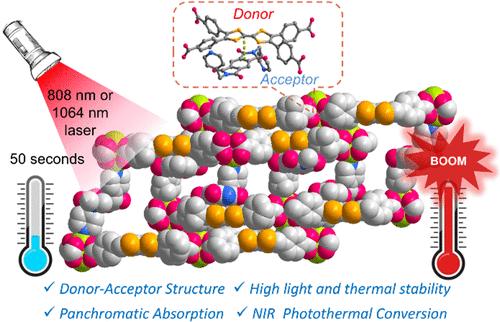Pyromellitic Diimide-Based Donor–Acceptor MOF with Panchromatic Absorption for High-Efficiency Photothermal Conversion
IF 4.7
2区 化学
Q1 CHEMISTRY, INORGANIC & NUCLEAR
引用次数: 0
Abstract
The incorporation of donor–acceptor components into metal–organic frameworks (MOFs) is an effective approach for developing efficient near-infrared (NIR) photothermal conversion materials; yet, their precise structural design and synthetic methodologies still present significant challenges. In this work, we present a distinctive MOF material Zn2(bpPDI)(TTFTB)·solvent (MOF 1) constructed by the coordinated assembly of donor–acceptor components, featuring a tetrathiafulvalene tetrabenzoate (TTFTB) electron donor and a bis-pyridyl-substituted pyromellitic diimide (bpPDI) electron acceptor. The material demonstrates significant intrinsic intermolecular electron-transfer capability and possesses a long-lived TTFTB•+ radical cation and a bpPDI•– radical anion. These characteristics enable panchromatic absorption spanning the visible to the second near-infrared (NIR-II) region, thus allowing efficient NIR photothermal conversion. Under NIR light irradiation, MOF 1 achieves efficient photothermal conversion (ΔTmax = 137 °C under 0.5 W cm–2 laser exposure), including rare NIR-II photothermal conversion capabilities, while exhibiting excellent thermal stability and cycling durability.

基于二酰二亚胺的全色吸收给受体MOF的高效光热转换
在金属有机骨架(mof)中加入供体-受体组分是开发高效近红外(NIR)光热转换材料的有效途径;然而,它们的精确结构设计和合成方法仍然面临着重大挑战。在这项工作中,我们提出了一种独特的MOF材料Zn2(bpPDI)(TTFTB)·溶剂(MOF 1),由供体-受体组份协调组装而成,具有四噻吩四苯甲酸酯(TTFTB)电子给体和双吡啶取代的苯二酰二亚胺(bpPDI)电子受体。该材料具有显著的分子间电子转移能力,并具有长寿命的TTFTB•+自由基阳离子和bpPDI•-自由基阴离子。这些特性使全色吸收跨越可见光到第二近红外(NIR- ii)区域,从而实现有效的近红外光热转换。在近红外光照射下,MOF 1实现了高效的光热转换(ΔTmax = 137°C, 0.5 W cm-2激光照射下),包括罕见的NIR- ii光热转换能力,同时表现出优异的热稳定性和循环耐久性。
本文章由计算机程序翻译,如有差异,请以英文原文为准。
求助全文
约1分钟内获得全文
求助全文
来源期刊

Inorganic Chemistry
化学-无机化学与核化学
CiteScore
7.60
自引率
13.00%
发文量
1960
审稿时长
1.9 months
期刊介绍:
Inorganic Chemistry publishes fundamental studies in all phases of inorganic chemistry. Coverage includes experimental and theoretical reports on quantitative studies of structure and thermodynamics, kinetics, mechanisms of inorganic reactions, bioinorganic chemistry, and relevant aspects of organometallic chemistry, solid-state phenomena, and chemical bonding theory. Emphasis is placed on the synthesis, structure, thermodynamics, reactivity, spectroscopy, and bonding properties of significant new and known compounds.
 求助内容:
求助内容: 应助结果提醒方式:
应助结果提醒方式:


